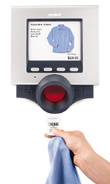Article
Micro Kiosks may bring maximum impact
Unicomp and Symbol have introduced "micro kiosks" touting a major advantage to retail kiosk buyers -- they're really, really small.
February 17, 2003
The future of kiosks is shrinking, or so it seemed as vendors introduced new products at the National Retail Federation annual convention in in New York in January.
Symbol Technologies (NYSE:SBL) and UniComp Inc. (OTC: UCMP) launched new "micro kiosk" products (the MK2000 and the CS-Link 1500, respectively) aimed at the healthcare, hospitality, manufacturing, and retail markets.
Symbol's MK2000, scheduled to ship in March, is priced starting at $2,000. The UniComp CS-Link 1500, available in late February, is listed at $1,900. Hand Held Products Inc. , based in Skaneateles Falls, N.Y., is expected to announce a micro product later this year.
As the name implies, the new products are small, with 6.4-inch diagonal screens. They're big on features, however.
John Britts, senior manager of marketing at Symbol, called micro kiosks the "evolution of the price checker."
"We are adding color graphics, slide shows, videos; any information to create better-informed buyers," said Britts. "Yes, there is the fundamental price-lookup function, but we can now offer much more detailed facts and push more marketing into the aisles."
What's in a name?
Industry analysts say the new products are interesting, but stop well short of calling them revolutionary in an industry rife with innovative product.
 |
Unicomp's CS-Link 1500 |
Jeff Roster, senior analyst of global industries, retail, for Gartner Group, said, "I don't like creating buzz words. You can call it anything you like; it's still a kiosk. I personally haven't heard that term `micro.' It just means `small.'"
Roster said there's no market category for micro kiosks. "A micro kiosk will still fit into the 'kiosk' category of my forecasts," said Roster, who believes the products will find buyers. "If vendors are adding capability to small kiosks, retailers will be interested. Conversations I've had indicate that retailers would put money down today on such products."
Francie Mendelsohn, president of Summit Research Associates, is optimistic about the products, too, though the term "micro kiosk" is new to her, too.
"It sounds like a good idea, but I'd lose that term `micro kiosk' in a hurry," she said.
The problem is that it might cause confusion in the marketplace. The purpose of the new products, vendors say, is not to muddle the market or replace the traditional kiosk, but to supplement it by providing multiple, less expensive touch points throughout a store or business.
Testing, Testing
Both Symbol and UniComp say they're testing their new devices in the field, though both cited competitive reasons for not disclosing details of their beta tests.
UniComp's Bryan Jorett, director of business development, described three customer scenarios:
The deli counter in a supermarket could use the micros to let customers put in an order, get a number, and then continue on with shopping.
"They could punch in that they want a pound of ham sliced thin, and then come back to the counter when the order is ready," Jorett said. "The same functionality could be placed in the bakery section."
He said that the micros could be used to encourage baseball fans to stay in their seats until the final out. Ticket holders would receive a bar-coded ticket to insert in any micro set up around the stadium. The micros could be programmed to award prizes, redeemable after the game.
"People tend to leave games after the seventh inning. This means a loss of money for concessionaires. Maybe we can keep those people in place using kiosk-driven incentives," said Jorett.
A restaurant could use micro kiosks at every table as a merchandising tool. "I could see a unit on a table allowing customers to check ingredients or calories of a menu item. Maybe the store could use the tool to sell desserts that the waiters aren't pushing enough," said Jorett.
 |
Symbol's MK2000 |
Symbol's Britts offered an example of a retail situation in which a customer buying a Game Boy, for instance, could query a micro kiosk about the type of batteries the product needs.
"We could tell them the type of battery, and then say, `oh, by the way, those batteries are right across the aisle.' There is so much opportunity for cross merchandising," he said.
The micros can also be used internally, as an employee-education tool. The products could help employees locate products, check inventory, and obtain current pricing information.
Britts said micros could help generate activity in loyalty programs. Customers could swipe their loyalty cards at micros set up in different sections of a store.
"The kiosk could project services or products specially selected for that customer. One-to-one marketing is how the Procter & Gambles of the world gain market share," said Britts.
Big Features
The Symbol MK2000 includes a 6.4-inch full-color display, integrated bar code scanner, 400-MHz processor, Microsoft CE operating system, stereo speakers and optional touchscreen, along with full audio and video capabilities. Its depth is less than four inches. It features a wireless or wired Ethernet connection and four programmable function buttons.
UniComp's CS1500 weighs only 2.5 pounds and is smaller than an 8-by-10 photo frame. The micro kiosk can interface with a host computer or server system, which means customers and/or employees always have access to updated information.
While the vendors are touting innovative applications, the big benefit of these products is size. But size is their limitation, too.
Said Jorett, "People need to understand that kiosks are naturally more interfaceable with a touchscreen. But there are limits when you're talking a 6.4-inch diagonal screen."










